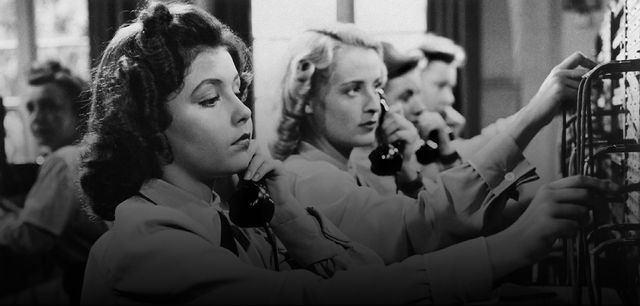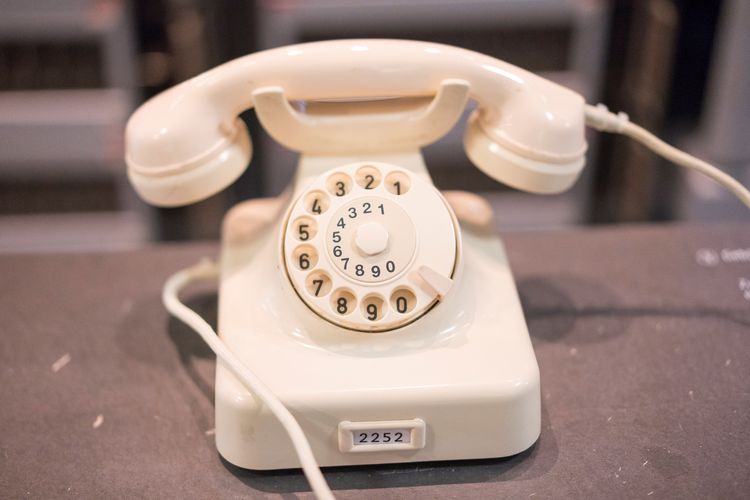05 january 2023
With innovations ranging from smoke and light signals to letters and telegrams, there has been no shortage of solutions for long-distance communication over the course of human history. But it took the invention of the telephone to make direct communication possible in real time. To find out how the phone was invented and how it has developed since, read on in our short history of the telephone.
Turn the dial with your index finger in the number hole until it hits the stop – and make your call. This rotary dial phone is on display in the Heinz Nixdorf MuseumsForum in Paderborn.
“Arrive Friday 5pm.” From its invention in the mid-19th century, electric telegraphy made communication faster than ever before. Once handed in at the telegraph office, the short message would reach its recipients via courier service in a matter of hours – across continents and oceans. This was important for trade relations in an age of burgeoning industrialisation, for stock exchanges, the military and railways, and to meet the growing need for information of a world which was fast becoming globalised. And yet, even with all its benefits, the telegram remained as exclusive a medium as it was rare. After all, you had to pay for every single character in a long-distance message. At the end of the 1870s, nearly one third of all telegrams sent from Germany consisted of no more than five words. This solution was simply too expensive for more detailed communication. But it did beg the question of how it would be if one were to use the existing technology as a basis for transmitting the human voice from one place to another electronically.
The child of many fathers
Beginning in the 1860s, people all over the world started tinkering with this idea. So, the telephone had much in common with many 19th century inventions which have changed our world forever: it was the child of many fathers. And, as is so often the case, one of them rose to prominence as the face of the innovation. In this case, his name was Alexander Graham Bell. This Scottish teacher of the deaf submitted his application for patent 174/465 to the patent office of the United States on 7 March 1876. For the “method and the apparatus for the telegraphic transmission of speech and other sounds through the stimulation of electronic wave motions, analogous to the vibrations of sound-transmitting air”. Bell thus beat his direct competitor, Elisha Gray, an engineer from Chicago, by just a few hours.
Philipp Reis and Antonio Meucci
Although Gray’s patent application went into greater technical detail, Bell was simply quicker off the mark and was awarded the patent for his “phonautograph“ on 7 March. It would later be said that Bell lifted material from his competitor’s patent document for the further development of his apparatus. It has been established beyond all doubt that he was greatly indebted to two of his other predecessors. One of them was Philipp Reis. This teacher of physics from Hesse had succeeded in 1861 in converting sound waves into electrical vibrations and converting them back into an audible format at the other end of a connecting wire. The sound quality was admittedly variable, and the communication only worked one way: the person at the other end of the line could hear but not answer. The “telephone”, as Reis christened his apparatus, was unveiled in many places, including the city of Edinburgh in Scotland, where Bell was born on 3 March 1847.
Alexander Graham Bell is widely held to be one of the pioneers in the development of the telephone. Here he is pictured opening the telephone line between New York and Chicago in 1892.
And the other was Antonio Meucci. This Italian American inventor had filed a provisional patent application back in the years 1871 to 1873 but had been unable to maintain it due to a lack of financial means. Bell also came across Meucci’s material and documents via a circuitous route. And yet, Bell would get the credit for all the processes on which Gray and Meucci worked so hard in the following years. It was only in 2002 that the US House of Representatives finally got around to honouring Antonio Meucci’s role in the introduction of the telephone.
Progress is made
Alexander Bell unveiled his apparatus for the first time in 1877 and went on to found the Bell Telephone Company in the same year. As AT&T, it would later become one the world’s most powerful telephone companies. In the same year, the first ever telephone conversation in Germany took place using a Bell apparatus. This used a microphone to convert sound into electrical signals which were then converted back into sound waves at the recipient’s end of the line.
And yet, telephoning using the funnel-shaped handset was not a particularly comfortable affair. This was because you had to keep moving the microphone and the loudspeaker back and forth from your mouth to your ear to be able to hear and be heard. It was not yet possible for the participants to interrupt one another during a telephone call. And you needed to listen very intently indeed: the voice quality was poor and the range low. Postmaster-General Heinrich von Stephan therefore commissioned Werner von Siemens with the task of building his own telephonic device based on the Bell apparatus. Before the year was out, the Siemens & Halske company had managed to achieve higher ranges and volumes. The latter were improved still further by the carbon microphone, which was independently developed by David Edward Hughes in Great Britain and Thomas Alva Edison and Emil Berliner in the US.
The girl in the exchange
It was on 1 April 1881 in Berlin that Germany’s first ever telephone network started operation. With 48 participants. By this time, nearly every major city in the US had its own network. And the German capital’s telephone network also grew fast. Berlin’s first telephone directory, which was published three months later, already featured 200 connections, a number which would swell to 4,300 by 1885. Alongside companies, banks, stock exchanges and hotels, only a select few well-heeled private citizens were represented. After all, with an annual usage fee of at least 200 marks, a telephone line cost twice as much as a two-room apartment in the capital city of the Reich.
In Germany, the callers were connected manually from 1889 by the “girls” in the telephone exchange. This was because higher voices were easier to understand due to the poor line quality. “And also because the caller finds it soothing when a woman’s voice comes out of the telephone,” as undersecretary of state Paul Fischer explained in the Reichstag in 1894.
It did not use to be possible to call someone yourself. In Germany, callers were connected manually from 1889 by the “girls” in the telephone exchange.
Dial and let dial
In 1889, Almon Strowger invented the “Strowger switch”, thereby laying the technical foundations for automatic call placement. 19 years later, in 1908, Europe’s first ever telephone exchange with dialling technology commenced operations in Hildesheim. The callers, who now numbered up to 900, were now able to make calls themselves in their local area. Anyone wanting to reach someone outside Hildesheim was, as before, reliant on the manual intervention of the girls in the exchange.
The first direct trunk dialling system in Germany went into operation in the Upper Bavarian town of Welheim in 1923. Available to callers were lines in the district capital and the surrounding villages. The rotary dial, which was patented by Siemens & Halske in 1913, was the means by which numbers were dialled. It made use of the pulse dialling method: the caller would use their index finger to rotate the dial until the numbers of choice reached the stop. After every digit dialled, a switch in the dial would generate a certain number of pulses. The exchange would use these to identify the number of the participant being called.
Telephones became ever more ergonomic as time went on. The microphone and speaker had long since been incorporated into a single receiver. And yet, economic crises and world wars hampered the development of the self-dialling system in Germany. In 1955, the first direct dial connection with another country was established between Lörrach and Basel. The last manually operated telephone exchange in Germany closed in 1966 – and the girls from the exchange were sent into retirement. In rural parts of the GDR, such telephone exchanges remained in use until the end of the 1980s.
The telephone becomes more mobile
The dual tone multi-frequency method was being developed in the US as early as the start of the 1960s. With this method, the numbers dialled were transmitted as sounds with specific frequencies, and the rotary dial was replaced by keys. The electronic system was faster and more reliable than the electromechanical rotary dial. But it would take until the mid-1980s for the push-button telephone to prevail in West Germany.
The phone doesn’t go to you – you go to the phone. Anyone looking to talk to their flock without being disturbed needed a long cable that would reach their bedroom. This would all change with cableless telephones, the first of which went on sale in Germany in 1984. Just one year earlier, Motorola had launched the very first commercial mobile phone. The DynaTAC 8000X weighed just under 800 grammes and was 33 centimetres long – meaning that there was no way it would fit in your jacket pocket. It needed to be recharged after only half an hour of use and cost 3,995 dollars – in today’s money, approximately 11,600 euros. Even so, some 300,000 users were soon to be seen holding this massive brick to their ear.
Now obsolete: after the Second World War, yellow phone boxes were a distinctive feature of German cities, towns and villages.
From the mobile to the smart phone
The Global System for Mobile Communications (GSM), the technical foundation for digital mobile phone networks, was introduced in 1992. Mobiles would become smaller and lighter in the following years. The year 1996 saw the launch of the first mobile with web browser, the Nokia Communicator 9000. The Communicator could be used to surf and to send faxes, emails and text messages. The “Short Message Service”, which soon became popular, was likewise made possible by the GSM standard. Mobile phone contracts and terminal devices became more affordable. In 1999, Nokia launched the 3210 model, which would go on to sell 160 million times worldwide. More than any smartphone.
The Simon, which was released by IBM in 1994, was the first of its kind. The clunky device’s touchscreen display was still only available in monochrome LCD and with low resolution. In January 2007, Apple unveiled the iPhone – and the smartphone revolution began in earnest. Some 3.9 billion people worldwide now have a smartphone. And our mobiles have long since morphed into multifunctional all-purpose devices, with the ability to make calls only one feature among many.
The mobile revolution eats its predecessors
Making calls when travelling is not of course an innovation of the modern age. This concept goes back a good 100 years: the first public telephone box was installed in New Haven in the US state of Connecticut in 1878. Three years later, Berlin could also boast its first telephone kiosk, payment for which involved a telephone ticket. The coin-operated phone followed in 1899. The first telephone boxes In Germany were yellow and blue, switching to red in 1934. After the Second World War, yellow was adopted as the mandatory colour in both West and East Germany. Telephone boxes became the defining feature of both towns and villages. They became the first port of call for all those people who could not afford their own telephone line or wanted to call home or ring other, more distant numbers when they were out and about. Wreathed in the odours of musty phone book paper and cold cigarette smoke, the user would feed coin after coin into the slot to prevent the connection to their relative or friend from going dead.
The times in which impatient queues would form at phone boxes are now a distant memory. Where there were some 170,000 phone boxes in Germany in 1999, that number has now shrunk to 12,000. All public phones are now mounted on silver posts with a rudimentary roof. The last yellow phone box was removed in Bavaria in 2019. In January 2023, Deutsche Telekom will retire the last remaining phone booths. For economic reasons: about one third of all public telephones were not used to make a single call in 2021. This should come as no surprise: after all, in phone booths you can neither surf the Net, nor take photos, watch YouTube videos or send cat gifs.
Nichts mehr verpassen: Jetzt kostenlosen #explore-Newsletter abonnieren







